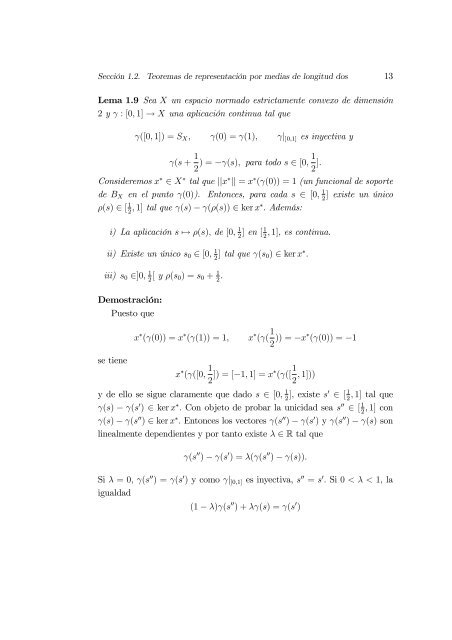Teoremas de tipo Krein-Milman y retracciones en espacios de Banach
Teoremas de tipo Krein-Milman y retracciones en espacios de Banach
Teoremas de tipo Krein-Milman y retracciones en espacios de Banach
You also want an ePaper? Increase the reach of your titles
YUMPU automatically turns print PDFs into web optimized ePapers that Google loves.
Sección 1.2. <strong>Teoremas</strong> <strong>de</strong> repres<strong>en</strong>tación por medias <strong>de</strong> longitud dos 13<br />
Lema 1.9 Sea X un espacio normado estrictam<strong>en</strong>te convexo <strong>de</strong> dim<strong>en</strong>sión<br />
2 y γ :[0, 1] → X una aplicación continua tal que<br />
γ([0, 1]) = SX, γ(0) = γ(1), γ|]0,1] es inyectiva y<br />
γ(s + 1<br />
1<br />
)=−γ(s), para todo s ∈ [0,<br />
2 2 ].<br />
Consi<strong>de</strong>remos x∗ ∈ X∗ tal que ||x∗ || = x∗ (γ(0)) = 1 (un funcional <strong>de</strong> soporte<br />
<strong>de</strong> BX <strong>en</strong> el punto γ(0)). Entonces, para cada s ∈ [0, 1]<br />
existe un único<br />
2<br />
ρ(s) ∈ [ 1<br />
2 , 1] tal que γ(s) − γ(ρ(s)) ∈ ker x∗ . A<strong>de</strong>más:<br />
i) La aplicación s 7→ ρ(s), <strong>de</strong> [0, 1<br />
2<br />
1 ] <strong>en</strong> [ , 1], es continua.<br />
2<br />
ii) Existe un único s0 ∈ [0, 1<br />
2 ] tal que γ(s0) ∈ ker x ∗ .<br />
iii) s0 ∈]0, 1<br />
2 [ y ρ(s0) =s0 + 1<br />
2 .<br />
Demostración:<br />
Puesto que<br />
x ∗ (γ(0)) = x ∗ (γ(1)) = 1, x ∗ (γ( 1<br />
2 )) = −x∗ (γ(0)) = −1<br />
se ti<strong>en</strong>e<br />
x ∗ (γ([0, 1<br />
2 ]) = [−1, 1] = x∗ (γ([ 1<br />
, 1]))<br />
2<br />
y<strong>de</strong>ellosesigueclaram<strong>en</strong>tequedados∈ [0, 1<br />
2 ], existe s0 ∈ [ 1,<br />
1] tal que<br />
2<br />
γ(s) − γ(s0 ) ∈ ker x∗ . Conobjeto<strong>de</strong>probarlaunicidadseas00 ∈ [ 1,<br />
1] con<br />
2<br />
γ(s) − γ(s00 ) ∈ ker x∗ . Entonces los vectores γ(s00 ) − γ(s0 ) y γ(s00 ) − γ(s) son<br />
linealm<strong>en</strong>te <strong>de</strong>p<strong>en</strong>di<strong>en</strong>tes y por tanto existe λ ∈ R tal que<br />
γ(s 00 ) − γ(s 0 )=λ(γ(s 00 ) − γ(s)).<br />
Si λ =0, γ(s00 )=γ(s0 ) ycomoγ|]0,1] es inyectiva, s00 = s0 . Si 0 < λ < 1, la<br />
igualdad<br />
(1 − λ)γ(s 00 )+λγ(s) =γ(s 0 )


